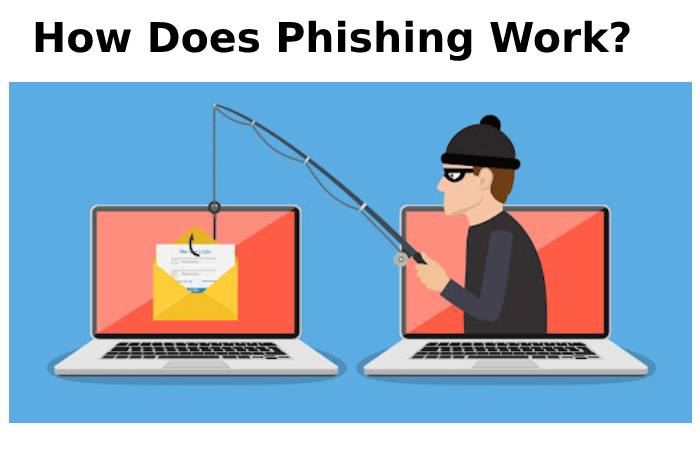Definition
What Is A Phishing Attack –A phishing attack is one of the oldest and quality-recognized scams on the Internet. It is a kind of telecommunications fraud that uses social engineering hints to obtain personal records from its sufferers We can define as many extraordinary ways.
What Are The Components Of Phishing?
The three components of a phishing attack
- The attack is accepted through electronic communications, such as emails or phone calls.
- The attacker impersonates an important person or organization.
- The goal is to obtain sensitive personal data such as login credentials or credit card numbers.
This is the deception from which phishing gets its name: the cybercriminal comes out of “fishing” (“fishing”, in English, with the same pronunciation as “phishing”) with an attractive “bait” to see if any victims bite the vast “ocean” of Internet users. The letters ph for “phishing” come from a hobby in the mid-20th century called “phone phreaking”, which consisted of experimenting with telecommunications networks to find out how they worked. Phreaking + fishing = phishing .
What Are The Effects Of Phishing?
Most phishing can result in the theft of identities or money and is also an effective technique for industrial espionage and data theft. Some hackers even go so far as to create fake social media profiles, spend time developing a relationship with potential victims, and wait for trust to spring the trap.
What is the cost of phishing?
There is not only financial damage in these cases, there is also a loss of confidence.
it isn’t high-quality to be scammed with the aid of a person we thought we should accept as true with; moreover, restoration can be gradual.
What Are The Different Types Of Phishing Scams?
There are some Scams. Explain Or Mention them Below.
Common Phishing Strategies & Target Phishing
Hackers can launch a wide range of attacks through the main phishing vectors we’ve outlined, from the technically admirable to the more classic scam. Target Phishing Large-scale phishing campaigns are like industrial fishing boats trying to catch as much as possible with their trawl nets. By contrast, spear phishing tailors its attacks to each specific target. Professional social networks like LinkedIn have popularized spear phishing against companies. As hackers can easily find all your employment information in one place.
Whaling & CEO Fraud To complete the nautical metaphors. We have whaling (“whaling”), which consists of phishing attacks directed against a specific person of high value. As we explain what Is A Phishing Attack it is the same as spear phishing but with much more ambitious goals. Not even top executives are immune to whaling attacks. CEO Fraud – Phishers pose as the chief executive officer (CEO) or any other company senior official to obtain payment or information about employees. CEO fraud campaigns are standard after a whaling attack, as the attacker has already accepted the executive’s credentials.
Pharming – Pharming attacks & Dropbox Phishing and Google Docs Phishing
Dropbox Phishing and Google Docs Phishing – (a mixture of “phishing” and “farming”, “cultivation”) use technological hints to trick you in preference to the standard bait. For instance, DNS spoofing, also referred to as DNS cache poisoning, is a pharming approach that could redirect you to a spoofed internet site. If you do not pay interest, you may not be aware the deception till it is too late.
Dropbox Phishing and Google Docs Phishing – Popular cloud services are appealing targets for phishing. Attackers fudge spoofed versions of login screens, get the recipient’s credentials as they enter them, and then binge on their files and data.
Cloning Phishing & Link tampering – Attackers take a legitimate email, “clone” it, and send an exact copy to all previous recipients, with one fundamental change. The links are now malicious. Link tampering Phishers send links that appear to lead to a URL, but when you click on them, they take you elsewhere. Common tricks include deliberate misspellings (e.g. “luna” and “Luna” look the same, but the latter uses capital i ) or using the name of a trusted website as the display text of a link. These attacks are also known as homographs.
Cross-site scripting
Sophisticated phishers can exploit weaknesses in a website’s scripts to hijack and use them for various purposes. Cross-site scripting is challenging to detect because everything on the website looks legitimate, from the URL to the security certificates.
How Does Phishing Work?

Whether they are carried out through email, social networks, SMS or any other system, all phishing attacks follow the same basic principles. The attacker sends a targeted communication to persuade the victim to click on a link, download an attachment, submit the requested information.
The nature of the deception is left to the imagination and skill of the attacker. With the appearance of social media, phishers have access to more non-public statistics about their goals than ever earlier than. Armed with this facts, they could first-rate-song assaults based at the goal’s desires, dreams, and life instances. They creating a much more compelling proposition. In these cases, social networks make much more powerful social engineering possible.
Conclusion
If we have to choose, spam is better. The main difference is that spammers do not try to harm the recipient. Spam is junk mail; it’s just a bunch of junk mail. Phishers want to steal your data and use it against you. Phishing is always trying to trick you. But “phishing phishing” is a term that refers explicitly to hackers attempting to impersonate legitimate companies or individuals to gain your trust.
Also read Touch To Unlock – Android Device, Finger Print Option, Removing ‘swipe to unlock’ And More
Newgrounds Video Downloader – How to download, Wonderful Memory, Highlights, And More
Related posts
Featured Posts
Gemtweaks.Com – About, Get Free Mod Games, Why Gemtweaks com Helpful?, And More
About Gemtweaks located at gemtweaks.com, which claims to be free apps tweak for iOS and Android, is a scam. The…
Lumos Marketing Group
Company’s Report Lumos Marketing Group remains a fundraising and also marketing company located in the Dallas area. We’ve ranked the…


